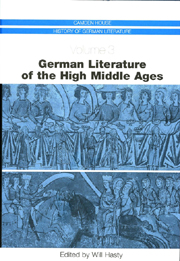Book contents
- Frontmatter
- Contents
- List of Illustrations
- Acknowledgments
- Introduction
- Part I The First Flourishing of German Literature
- Part II Lyric and Narrative Traditions
- Part III Continuity, Transformation, and Innovation in the Thirteenth Century
- Part IV Historical Perspectives
- Court Literature and Violence in the High Middle Ages
- Mobility, Politics, and Society in Medieval Germany
- Bibliography
- Notes on the Contributors
- Index
Court Literature and Violence in the High Middle Ages
from Part IV - Historical Perspectives
Published online by Cambridge University Press: 05 February 2013
- Frontmatter
- Contents
- List of Illustrations
- Acknowledgments
- Introduction
- Part I The First Flourishing of German Literature
- Part II Lyric and Narrative Traditions
- Part III Continuity, Transformation, and Innovation in the Thirteenth Century
- Part IV Historical Perspectives
- Court Literature and Violence in the High Middle Ages
- Mobility, Politics, and Society in Medieval Germany
- Bibliography
- Notes on the Contributors
- Index
Summary
VIOLENCE, ESPECIALLY IN ITS politically most prominent form as military force, is an essential and complex feature of the German literary landscape in the High Middle Ages. In order to understand the role of violence in this literature it is necessary to reflect on the use of force as a cultural and historical variable so as to avoid projecting onto medieval German literature concepts of violence and its relation to ethical, political and social values that belong to other historical contexts.
In modern societies the licit use of armed force is generally seen as a prerogative of the state, not the individual. The position was different in Germany during the Middle Ages, when some individuals still had the right to settle their disputes by military means, in trial by combat or in the process of feud. The carrying of knightly arms was seen as the hereditary right of a particular sector of society, the aristocracy. Moreover, the socially demarcating function of arms was becoming increasingly prominent during the literary upsurge of the twelfth and thirteenth centuries as even the lesser knighthood sought to close itself off from other sectors on the criterion of a hereditary right of arms. As a result of these factors there was considerable interpenetration of the military and everyday life at this time, as social status was largely defined, for the secular audiences of aristocratic poetry, by a right of arms that was never forgotten, even in peacetime, while the conduct of military action was seen as primarily a matter for the aristocracy.
- Type
- Chapter
- Information
- German Literature of the High Middle Ages , pp. 263 - 276Publisher: Boydell & BrewerPrint publication year: 2006



